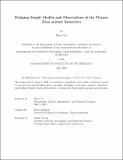Bridging Simple Models and Observations of the Flexure Zone around Antarctica
Author(s)
Cao, Rina
DownloadThesis PDF (4.322Mb)
Advisor
Minchew, Brent
Terms of use
Metadata
Show full item recordAbstract
This study evaluates whether the length of ice flexure zones in Antarctica can be used to infer the thickness of the ice and the effective Young’s modulus using a 1-D linear elastic beam bending model. The ice flexure zone is defined as the transition region between the grounded ice sheet and the free floating ice shelves, where the ice flexes due to the rise and fall of ocean tides. Surface elevation data from ICESat-2 were analyzed at several sites on the Ross Ice Shelf, and flexure bounds were identified using a derivative-based detection algorithm. The logarithmic relationship between the flexure length and the ice thickness consistently deviated from the predicted 4/3 slope, and the calculated values of Young’s modulus ranged widely, often exceeding the physically plausible limits. Furthermore, the flexure limits identified by the algorithm showed inconsistencies with the idealized beam-bending model. These results indicate that the assumptions of linear elasticity, constant thickness, and simple geometry are likely violated in real flexure zones. More sophisticated modeling approaches are needed to accurately capture the mechanics of ice shelf flexure zones.
Date issued
2025-05Department
Massachusetts Institute of Technology. Department of Earth, Atmospheric, and Planetary SciencesPublisher
Massachusetts Institute of Technology